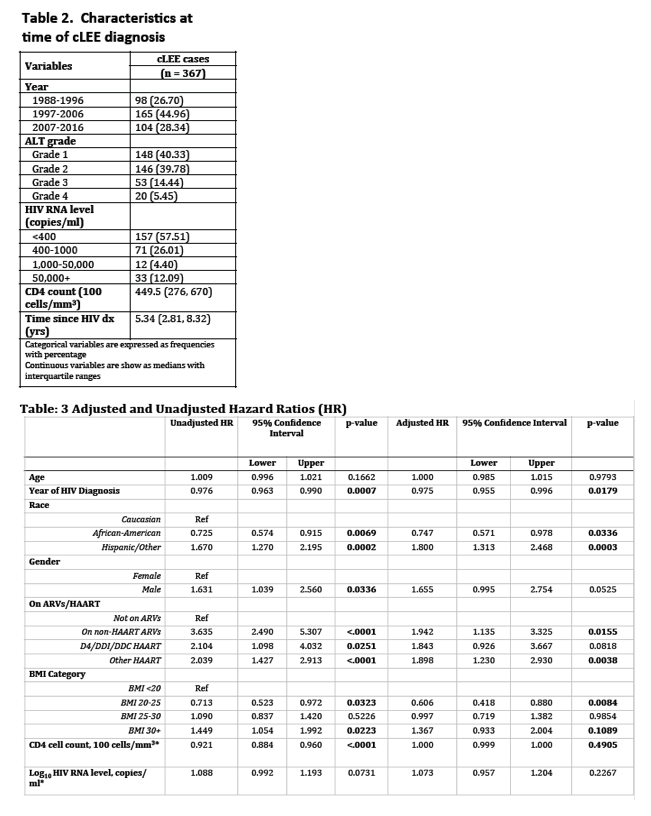 |
 |
 |
| |
The Incidence and Risk Factors Associated with Chronic Liver Enzyme Elevation (cLEE) in HIV-Monoinfected Persons - Antiretroviral Use and Race Predict High Liver Enzymes in HIV-Monoinfected
|
| |
| |
Download the PDF here
Antiretroviral Use and Race Predict High Liver Enzymes in HIV-Monoinfected
IDWeek2017/IDSA, October 4-8, 2017, San Diego
from Jules: with the aging population chronic elevated liver enzymes is an important issue, these elevations could worsen and be associated with statin intolerance, fatty liver & NASH, and liver cirrhosis without HCV or HBV.
Mark Mascolini
Antiretroviral therapy doubled chances of chronic liver enzyme elevation (cLEE) in a 2954-person study of US military personnel with HIV but without hepatitis virus infection [1]. Hispanics proved almost twice as likely as whites to have cLEE, while blacks had a 25% lower chance than whites.
US military researchers noted that cLEE remains common in people with HIV, affecting about 40% to 60% of patients taking antiretroviral therapy. But its meaning in HIV patients not infected with HBV or HCV remains unclear. They conducted this analysis of the US Military HIV Natural History Study (NHS) to determine the incidence of cLEE in HIV-monoinfected people and to identify risk factors.
NHS cohort members make twice-yearly visits in which they meet with an HIV specialist and give samples for analysis. The cLEE study involved NHS participants who had at least 6 months of follow-up after 1996, tested negative for HBV and HCV, and had a grade 0 baseline alanine aminotransferase (ALT). The researchers defined cLEE as ALT grade 1 (at least 1.25 times the upper limit or normal) or higher recorded at 2 or more visits in a period of 6 months within 2 years. They used multivariate Cox proportional hazards models to pinpoint independent cLEE risk factors.
The 2954 study participants had a median age of 27.8 years; 93% were men, 46% black, 40% white, and the rest Hispanic or another race/ethnicity. During 5.6 years of follow-up, cLEE developed in 367 people. Incidence stood at 1.53 per 100 person-years and period prevalence at 13.7%. The highest proportion of cLEE cases were grade 1 (40.3%), followed closely by grade 2 (39.8%). Only 14.4% had grade 3 cLEE and 5.45% grade 4.
People with cLEE differed significantly from those without in older age (median 29.4 versus 27.6, P = 0.0001), earlier HIV diagnosis year (1994 versus 2001, P < 0.0001), more years on antiretroviral therapy (median 4.1 versus 1.7, P < 0.0001), and lower nadir CD4 count (216 versus 307, P < 0.0001).
Multivariate analysis determined that Hispanics had an 80% higher risk of cLEE than whites (adjusted hazard ratio [aHR] 1.8, P = 0.0003), while blacks had a 25% lower risk than whites (aHR 0.75, P = 0.0336). Men had a 66% higher cLEE risk than women (aHR 1.655, P = 0.0525). Taking combination antiretroviral therapy (cART) almost doubled chances of cLEE (aHR 1.9, P = 0.0038), as did taking non-cART antiretrovirals (aHR 1.9, P = 0.0155). Having a normal body mass index (20 to 25 kg/m(2) versus under 20) lowered the risk of cLEE (aHR 0.61, P = 0.0084).
The researchers noted that cLEE incidence in their cohort (1.53 per 100 person-years) is lower than in other HIV cohorts, perhaps because of the young age of their study group and low rates of drug injecting and comorbidities. They suggested that the association between antiretroviral use and cLEE underlines the need to monitor liver enzymes in people taking antiretrovirals. The association with antiretroviral therapy remained significant even after the investigators eliminated older hepatotoxic drugs from the analysis.
Reference
1. Wood S, Byrne M, Deiss R, et al. The incidence and risk factors associated with chronic liver enzyme elevation (cLEE) in HIV-monoinfected persons. IDWeek2017/IDSA. October 4-8, 2017. San Diego. Abstract 597.
Poster pdf attached
Download the PDF here

The Incidence and Risk Factors Associated with Chronic Liver Enzyme Elevation (cLEE) in HIV-Monoinfected Persons
Shannon Wood, MD, MPH1, Morgan Byrne2,3, Robert Deiss, MD2,3,4, Jason Okulicz, MD2,5, Thomas O'Bryan, MD2,3,5, Ryan Maves, MD2,4, Christina Schofield, MD6, Tomas Ferguson, MD2,6,7, Timothy Whitman, DO1,2, Brian Agan, MD2,3, Anuradha Ganesan, MD, MPH1,2,3
1Walter Reed National Military Medical Center, Bethesda, MD; 2Infectious Disease Clinical Research Program, Department of Preventive Medicine and Biostatistics, Uniformed Services University of the Health Sciences, Bethesda, MD; 3The Henry M. Jackson Foundation for the Advancement of Military Medicine, Inc., Bethesda MD; 4Naval Medical Center San Diego, San Diego, California; 5San Antonio Military Medical Center, Fort Sam Houston, TX; 6Madigan Army Medical Center, Takoma, WA; 7Tripler Army Medical Center, Honolulu, HI




|
| |
|
 |
 |
|
|